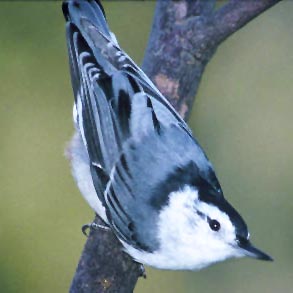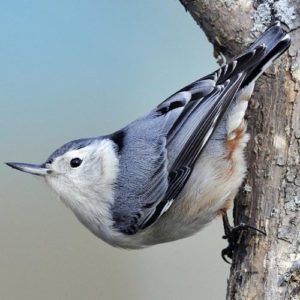In the eastern U.S., we have three species of nuthatch. The most common and widespread species is the white-breasted nuthatch (Sitta carolinensis). In fact, the white-breasted nuthatch is a year-round resident throughout most of the U.S. It can be found in forests, along the edges of woodlots, and in suburbs and urban areas with large numbers of trees. In the winter, it is a common visitor to bird feeders.
The white-breasted nuthatch is our largest nuthatch, but is still a little smaller than a titmouse. It has an almost pure white belly, often with rusty-colored feathers near the rump. The back is a steely gray color. The side of the face is the same bright white as the belly and really makes the nuthatch’s black eye standout. The top of the head has either a dark black or a steely gray stripe going from the base of its charcoal gray to black bill all the way to the base of its neck. If the top of the head is gray, then it is a female. However, if the top of the head looks black, then it isn’t so clear-cut.

Sexing white-breasted nuthatches as they hop around in the trees or at your birdfeeder can be hard, because although males never have gray head stripes, some females can have very dark stripes. The percentage of females with the darker head stripes increases the further south you go. Most females, even those with the darkest of head stripes, will have some gray tipped feathers mixed in on the head, but those may only be visible if the bird is being viewed up-close and under very good light. Researchers can also use some slight differences in the wings of male and female white-breasted nuthatches to help determine the bird’s sex when they have captured it. However, once again, these characteristics are only visible when the bird is in hand and being examined up-close.
White-breasted nuthatches eat a variety of foods, depending in part on the time of year. In the summer, their diet is completely made up of “bugs.” They are known to eat spiders, caterpillars, beetles and beetle larvae, stink bugs, ants, and many other insects. Nestlings are only fed bugs. The high-protein diet helps them grow and develop faster. In the winter, white-breasted nuthatches still eat bugs when they can, but they also eat sunflower seeds, acorns, peanuts, and other nuts and seeds. One study found that in the winter, up to 60% of their diet could be vegetarian. It’s during the winter that you are most likely to see white-breasted nuthatches visiting your feeders. They’ll also visit suet feeders if you have them up.
You may notice that white-breasted nuthatches at your feeder will often grab a seed and fly off. Sometimes they’ll land on a nearby perch and you’ll be able to see them hold the seed with their foot and peck at it to break it open before consuming it. It’s this hatcheting behavior that gave them their common name – nuthatch. Other times, they’ll fly off and cache the seeds under a piece of loose bark or in a tree furrow. Like squirrels burying a nut, this is the white-breasted nuthatch’s way of saving the seed or nut for later.

When they aren’t at your feeders, white-breasted nuthatches are most often spotted hopping up and down tree trunks and branches. They are looking for bugs or seeds hiding under any loose bark, loose pieces of moss or lichen, or in cracks and furrows in the tree. You will often see them stop and tilt their heads back slightly to look around, especially when they are foraging down a tree. That stance is very characteristic of nuthatches and is an easy way to identify a bird as a nuthatch even if you don’t get a very good look at it. All nuthatches have that stance, but for many of us, the white-breasted nuthatch is our only nuthatch option for most, if not all, of the year.
White-breasted nuthatches are non-migratory and maintain year-round territories. However, those territories may become more loosely defined in the winter when they will sometimes join foraging flocks of titmice and chickadees. The male and female are considered monogamous and will occupy a shared territory throughout the year. In late winter, they will begin searching for a nesting site such as a natural hollow in a tree or an old woodpecker nesting cavity. They may even re-use the same nesting site from one year to the next.
The female will gather a variety of soft materials and use them to build a nest in the cavity. She’ll then lay 5-9 eggs and incubate them for a week and a half to two weeks. While she is incubating the eggs, the male will bring her food. After the eggs hatch, both parents will feed the nestlings until they fledge. Scientists still aren’t sure exactly how long the nestlings will remain in the nest. How long it takes the nestlings to fledge seems to vary. As the parents come and go from the nesting site, they will often spend up to several minutes rubbing a beetle or other insect around the entrance of the cavity before leaving. It is thought that this odd behavior might help to throw off or otherwise deter nest predators such as squirrels.
White-breasted nuthatches have several different songs and calls. However, the most familiar is a low, nasally “yank, yank, yank.” One study that was conducted in the D.C. area and published in 2010 found that white-breasted nuthatches were less common than would be expected in areas with lots of traffic. The researchers believed that this was probably because the traffic noise occurred at the same frequencies as the white-breasted nuthatch’s calls, and thus drowned out the nuthatch’s vocalizations. It would then make sense for white-breasted nuthatches to avoid areas that were so noisy they could no longer communicate.
For most of us, traffic noise isn’t likely to be too detrimental to our nuthatch populations. However, it is something to keep in mind and white-breasted nuthatches aren’t the only species that has been shown to be negatively impacted by anthropogenic noise. The good news is that overall, white-breasted nuthatch populations are considered stable to increasing slightly. Because they will often visit winter bird feeders, white-breasted nuthatches are a great bird to get to know for those who are just starting to identify birds. Before long, you’ll likely be noticing them even when they aren’t at your feeders, including while they are hopping up and down the trees in your yard or while they are calling to each other, even when you can’t see them.

Backyard Ecology: Exploring Nature in Your Backyard
Nature isn’t just “out there.” It’s all around us, including right outside our doors. Hi, my name is Shannon Trimboli, and I am the host of Backyard Ecology. I live in southcentral Kentucky and am a wildlife biologist, educator, author, beekeeper, and owner of a nursery specializing in plants for pollinators and wildlife conservation. I invite you to join me as we ignite our curiosity and natural wonder, explore our yards and communities, and improve our local pollinator and wildlife habitat. Learn more or subscribe to my email list at www.backyardecology.net.

Leave a Reply